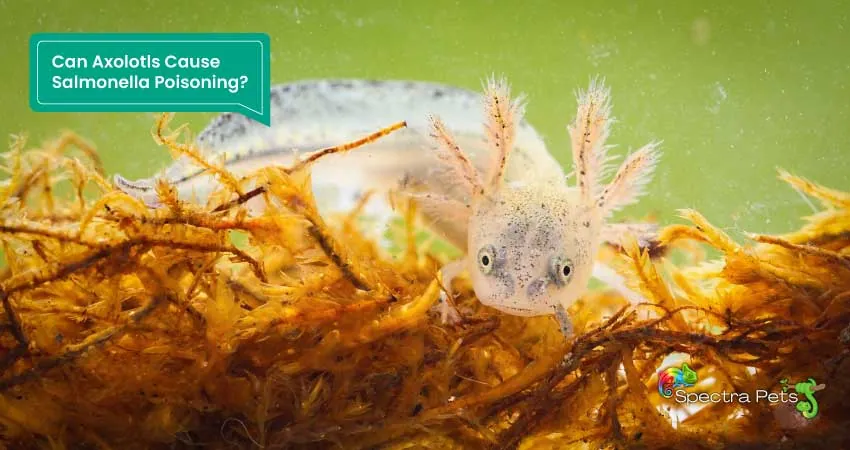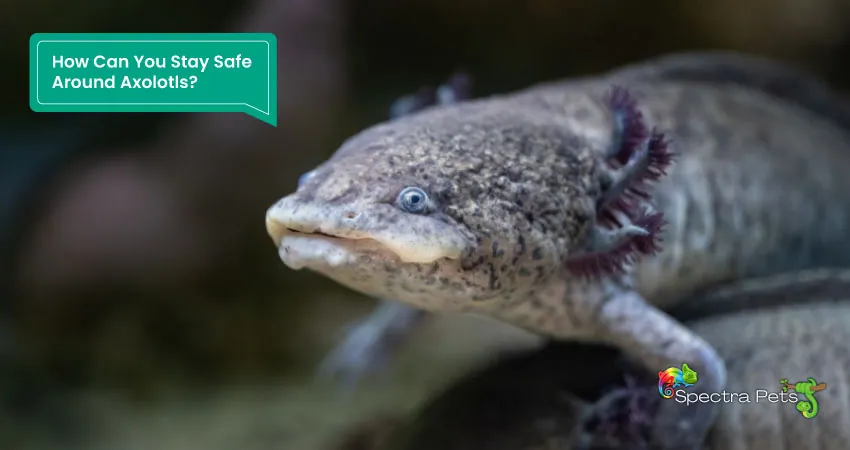Axolotls, scientifically known as Ambystoma mexicanum, are unique creatures that have piqued the curiosity of both pet enthusiasts and researchers worldwide. Originating from the remnants of Xochimilco, a system of lakes and canals near Mexico City, these aquatic salamanders are renowned for their remarkable regenerative abilities. According to a study published in the journal ‘Nature’, axolotls can regenerate not only limbs but also their spinal cord, heart, and other organs, a feature that sets them apart in the animal kingdom.
Despite their fascinating characteristics, a common question that arises is: “Are Axolotls Poisonous?” To answer this question, it’s essential to understand that Axolotls, unlike some of their amphibian counterparts, do not produce toxins that could harm humans or other animals. However, they can carry bacteria, such as Salmonella, which could potentially cause diseases under certain conditions.
In a study conducted by the Centers for Disease Control and Prevention (CDC), it was found that reptiles and amphibians, including axolotls, can carry Salmonella in their digestive tract without appearing sick, which can contaminate their environment and anything within it. Therefore, while axolotls are not inherently poisonous, they should be handled with care to ensure both your safety and theirs.
This article aims to provide a comprehensive understanding of axolotls, focusing on their potential to carry diseases, the risks associated with keeping them as pets, and the precautions necessary for their safe handling. By understanding these aspects, prospective and current axolotl owners can ensure a safe and healthy environment for these fascinating creatures.
Are Axolotls Poisonous to Humans or Other Animals?

Axolotls are not inherently poisonous to humans or other animals. They do not produce toxins that could harm humans or pets. However, they can carry bacteria that could potentially cause diseases, especially under poor living conditions. It’s important to note that while axolotls are not poisonous, they should be handled with care to ensure both your safety and theirs.
According to a study published in the Journal of Veterinary Diagnostic Investigation, axolotls can carry a variety of bacteria, including Aeromonas, Pseudomonas, and Flavobacterium. However, these bacteria are generally not harmful to humans unless the person has a compromised immune system.
Can Axolotls Cause Salmonella Poisoning?

While axolotls themselves are not poisonous, they can become carriers of diseases, such as Salmonella, under certain conditions. Salmonella is a type of bacteria that can cause food poisoning in humans. Let’s explore the two main ways axolotls could potentially cause Salmonella poisoning.
Poor Health and Living Conditions
Poor water conditions can make axolotls carriers of diseases. If their living environment is not properly maintained, harmful bacteria, including Salmonella, can thrive. These bacteria can then be transmitted from axolotls to humans, especially if the human handler does not practice good hygiene.
Eating Contaminated Food
Another potential risk of Salmonella poisoning comes from consuming axolotls as food. While this is not a common practice in most parts of the world, in some cultures, axolotls are considered a delicacy. If the axolotl is infected with Salmonella and is not properly cooked, the bacteria can be transmitted to the person consuming it.
Are Axolotls Dangerous?

Axolotls are generally not dangerous to humans. They are not aggressive creatures and do not pose a threat unless they feel threatened or stressed. However, they can pose dangers to other fish and pets in the same tank due to their carnivorous nature.
Misconceptions About Axolotls Being Aggressive
There are some misconceptions about axolotls being aggressive creatures. However, these are largely unfounded. Axolotls are quite docile and prefer to keep to themselves. They do not show aggression towards humans unless they feel threatened.
Dr. Randal B. Draftz, a veterinarian and axolotl expert, states that “Axolotls are generally very peaceful creatures. They may nip at each other if kept in close quarters, but they are not known to be aggressive towards humans.”
Dangers to Other Fish and Pets in the Tank
While axolotls are not dangerous to humans, they can pose a threat to other fish and pets in the same tank. Axolotls are carnivorous and may see smaller fish and pets as potential food. Therefore, it’s important to consider this when deciding on the right mix ofspecies in your aquarium.
According to the Axolotl Conservation, Research and Education Initiative (ACREI), axolotls have been known to eat small fish, crustaceans, and even other axolotls if they are small enough. Therefore, it’s recommended to keep axolotls in a species-specific tank or with other creatures of similar size to prevent potential predation.
What Are the Dangers of Keeping Axolotls?

Keeping axolotls as pets comes with its own set of challenges and potential dangers. Let’s explore some of these.
Axolotls May Bite Their Owners
Axolotls, while generally docile, can occasionally bite their owners. However, this is not an act of aggression. Instead, it’s a case of mistaken identity, with the axolotl confusing a hand for food. If you find yourself bitten, it’s crucial to remain calm. Abruptly pulling your hand away could harm the axolotl’s small, delicate teeth, causing discomfort for your pet.
Instead, patiently wait for your axolotl to release its grip. Once it realizes your hand isn’t food, it will let go. This approach ensures the safety of both parties involved.
While an axolotl bite is unlikely to cause severe pain due to their small teeth, it’s still important to take care of the bitten area. Immediately clean and disinfect the wound to prevent potential bacterial infection from the axolotl’s mouth or the tank water.
Furthermore, it’s advisable to let the wound heal completely before placing your hand back in the axolotl’s tank. This not only prevents the wound from coming into contact with potentially contaminated water but also deters the axolotl from biting the same spot again.
Dr. Jennifer Coates, a veterinarian and advisory board member for Pet Life Today, suggests that “If you are bitten by an axolotl, wash the area with warm soapy water, apply an over-the-counter antibiotic ointment, and cover it with a clean bandage.”
In summary, while axolotl bites are typically not a cause for concern, they should be handled with care. Understanding your axolotl’s behavior and taking the necessary precautions can ensure a safe and harmonious coexistence.
Axolotls Can Be Carriers of Salmonella
As mentioned earlier, axolotls can be carriers of Salmonella, especially if they live in poor conditions. Salmonella poisoning can cause symptoms such as diarrhea, fever, and abdominal cramps in humans. In severe cases, it can even lead to hospitalization.
The CDC reports that each year Salmonella causes about 1.35 million infections, 26,500 hospitalizations, and 420 deaths in the United States. Proper hygiene and care can significantly reduce the risk of Salmonella infection from axolotls.
Axolotls’ Feeding Habits and Potential Dangers to Other Aquarium Inhabitants
Axolotls are carnivorous by nature. They feed on a variety of foods including worms, small fish, and crustaceans. In a tank environment, they may pose a threat to other smaller inhabitants. It’s important to consider this when deciding on the right mix of species in your aquarium.
How Can You Stay Safe Around Axolotls?

While axolotls are generally safe to handle and keep as pets, there are certain precautions that you should take to ensure your safety and the health of the axolotl.
Provide a Clean Habitat
One of the most important aspects of keeping axolotls is providing them with a clean and stress-free environment. This includes maintaining the right water temperature and pH levels, and regularly cleaning the tank to prevent the buildup of harmful bacteria. A well-maintained habitat not only keeps your axolotl healthy but also reduces the risk of disease transmission.
The Axolotl Care Guidelines from the University of Kentucky recommend a water temperature of 60-64°F (16-18°C) and a pH level of 7.4-7.6 for optimal axolotl health.
Be Careful While Feeding
Feeding time can be a tricky situation, as axolotls may mistake your fingers for food and bite. To avoid this, you can use feeding tongs or a similar tool to deliver food to your axolotl. Also, ensure that the food you provide is safe and suitable for axolotls.
Maintain Proper Hygiene
Maintaining proper hygiene is crucial when handling axolotls. Always wash your hands before and after handling your axolotl or cleaning its tank. This helps prevent the spread of bacteria and other pathogens.
Conclusion
In conclusion, axolotls are not poisonous, but they can carry diseases under certain conditions. Proper care and hygiene are essential when keeping axolotls as pets. By understanding the potential risks and taking the necessary precautions, you can ensure a safe and healthy environment for your axolotl and yourself.
Remember, responsible axolotl care involves understanding their needs, providing a suitable environment, and taking precautions to prevent disease transmission. With the right care and attention, axolotls can make fascinating and rewarding pets.
Axolotls are truly unique creatures. Their care can be a bit challenging, but the rewards are worth it. Just remember to always handle them with care, keep their environment clean, and monitor their health closely.
This comprehensive guide should provide you with the necessary information and confidence to handle and care for axolotls safely. Whether you’re a potential axolotl owner or just fascinated by these remarkable creatures, understanding their nature and needs is the first step towards responsible and enjoyable axolotl care.
